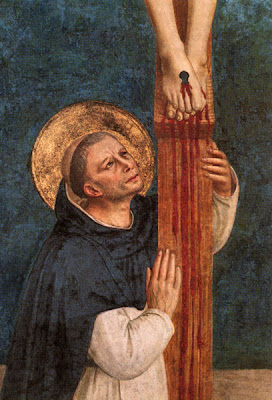See My Hands And My Feet: A Lenten Meditation
Recently, one of our Sisters had to have an MRI taken of her foot in order to rule out a fracture. This sister previously underwent an ankle reconstruction surgery along with the repair of tendons. It was a painful process and a long recovery. Last year, the 2 screws that held her heel in place were removed. The cartilage has totally grown into the spaces where the screws were and everything is healed.
Much to her surprise, when she looked at the MRI she could clearly see the “imprint” of the screws even to the details of the threading lines. Those screws that were both a source of pain and healing remain imprinted in her body.
Why do I mention this? Because it gave me new insight into our Lord’s passion and death for our salvation. Immediately, I recalled to mind the story of
So, is there a connection? I believe there is. After the Resurrection, Jesus joyously showed the wounds from his Passion gloriously radiant. Forever, they remain with Him even in Heaven for He is always Incarnate. He did not throw off his mortal body on ascending to be with the Father and the Holy Spirit once more in Heaven. Instead his body, the means for which we have been redeemed and saved from sin, shares in the glorious triumph over sin and death pointing to the promise that one day our bodies will share in the glory of the Resurrection.
The Fathers of the Church like to say that that the nails which pierced Jesus body and fastened him to the Cross symbolize our sins. Christ’s wounds, which are the result of the nails, are the entry way for us into the heart of God. “By His wounds you were made healed!” (1 Pt. 2:25)
Perhaps, like the image on Sister’s MRI, we could say that the imprint of the nails, the imprint of our sins, remains with Christ forever, hidden in his wounds, and interceding with the Father of Mercies. Our sins are entirely forgiven by Jesus’ Passion and Death. The “memory” of them, the mark of them, now belongs totally and entirely to Him who knew not sin. They are ours no longer!
This should be a great cause of hope and joy for us! At the beginning of the novitiate and at profession, each Dominican friar and nun asks for only one thing, “God’s mercy and yours.” Such a request presumes that we are truly in need of and desire God’s mercy! The memoria of our sins, hidden forever in Christ, assures us that God’s mercy, literally his heart-of-sorrow or affliction, will never be denied us. More than that, it brings joy to God and to the whole court of heaven! In the Herald of Divine Love,
The Shepherd of our souls tells us, “I have swept away your transgressions like a cloud, your sins like a midst, return to me for I have redeemed you.” (Is. 44:22) Too often, however, we say we have received the gift of our Lord’s forgiveness, especially in the Sacrament of Confession, but in practice we continue to act and live otherwise. To hold onto our sins and to act that Christ’s forgiving love is not true, is to repeat that first sin that happened at another tree in the Garden of Eden. Let us not be misers, shutting ourselves off from the gifts of grace our loving Savior so much wants to give us!
